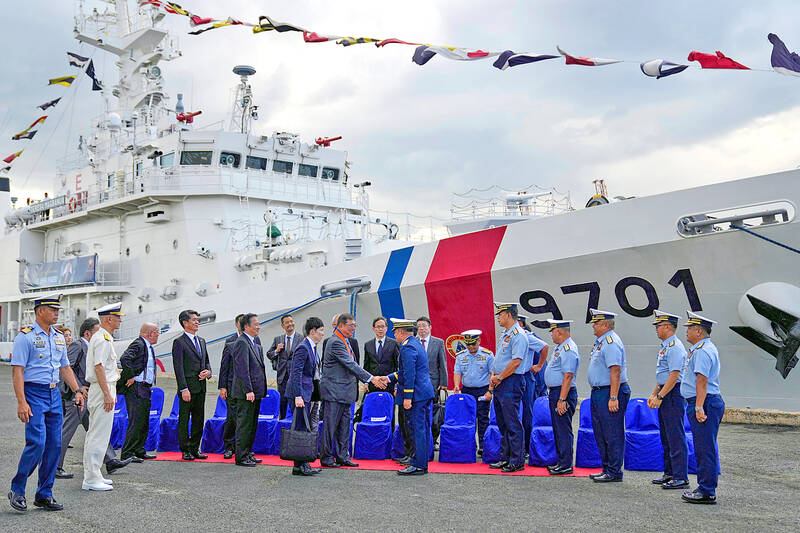China has removed its last buoy from Japanese economic waters, a Japan Coast Guard spokesman said yesterday, in what might be a move by Beijing to improve ties.
Japan in December last year said that it had spotted a new buoy in its exclusive economic zone south of Yonaguni Island, near Taiwan, and demanded that China remove it immediately.
The Japan Coast Guard issued a statement late on Wednesday saying that the buoy was no longer in place.

Photo: AP
A spokesman yesterday told reporters that it means all Chinese buoys in Japanese economic waters have been removed.
Japanese media said this could signal an intention by Beijing to improve ties with Tokyo, as China faces political and economic pressure from US President Donald Trump’s government.
“I decline to speculate on China’s intentions,” Japanese Chief Cabinet Secretary Yoshimasa Hayashi told reporters when asked about the removal of the buoy.
Beijing had in July 2023 installed another buoy within the nation’s exclusive economic zone — near the Diaoyutais (釣魚台), a group of islets that Japan controls and calls the Senkakus, but are also claimed by Taiwan and China.
In February, China moved that buoy out of Japan’s zone, the coast guard spokesman said.
Separately, The Philippine Ministry of Foreign Affairs yesterday said that China has no right to object to or interfere with its lawful and routine activities in the South China Sea.
The ministry said that it also “rejects and refutes” statements by the Chinese embassy in Manila that Beijing has indisputable sovereignty over the Spratly Islands (Nansha Islands, 南沙群島).
Taiwan, the Philippines, Malaysia, Vietnam and China between them have claims and a presence on dozens of features in the Spratly archipelago, ranging from reefs and rocks to islands, natural and artificial.
“We urge China to respect the Philippines’ sovereignty and jurisdiction, even as we continue to pursue peaceful and legal means to manage differences and the situation at sea,” ministry spokeswoman Teresita Daza said in a statement.
“The Philippines is clearly within its rights to conduct routine maritime operations and scientific research in and around these features, and will continue to do so,” Daza said.
“China has no right to object much less interfere with these lawful and routine activities,” she added.
Additional reporting by Reuters

WAITING GAME: The US has so far only offered a ‘best rate tariff,’ which officials assume is about 15 percent, the same as Japan, a person familiar with the matter said Taiwan and the US have completed “technical consultations” regarding tariffs and a finalized rate is expected to be released soon, Executive Yuan spokeswoman Michelle Lee (李慧芝) told a news conference yesterday, as a 90-day pause on US President Donald Trump’s “reciprocal” tariffs is set to expire today. The two countries have reached a “certain degree of consensus” on issues such as tariffs, nontariff trade barriers, trade facilitation, supply chain resilience and economic security, Lee said. They also discussed opportunities for cooperation, investment and procurement, she said. A joint statement is still being negotiated and would be released once the US government has made

Authorities have detained three former Taiwan Semiconductor Manufacturing Co (TMSC, 台積電) employees on suspicion of compromising classified technology used in making 2-nanometer chips, the Taiwan High Prosecutors’ Office said yesterday. Prosecutors are holding a former TSMC engineer surnamed Chen (陳) and two recently sacked TSMC engineers, including one person surnamed Wu (吳) in detention with restricted communication, following an investigation launched on July 25, a statement said. The announcement came a day after Nikkei Asia reported on the technology theft in an exclusive story, saying TSMC had fired two workers for contravening data rules on advanced chipmaking technology. Two-nanometer wafers are the most

NEW GEAR: On top of the new Tien Kung IV air defense missiles, the military is expected to place orders for a new combat vehicle next year for delivery in 2028 Mass production of Tien Kung IV (Sky Bow IV) missiles is expected to start next year, with plans to order 122 pods, the Ministry of National Defense’s (MND) latest list of regulated military material showed. The document said that the armed forces would obtain 46 pods of the air defense missiles next year and 76 pods the year after that. The Tien Kung IV is designed to intercept cruise missiles and ballistic missiles to an altitude of 70km, compared with the 60km maximum altitude achieved by the Missile Segment Enhancement variant of PAC-3 systems. A defense source said yesterday that the number of

Taiwanese exports to the US are to be subject to a 20 percent tariff starting on Thursday next week, according to an executive order signed by US President Donald Trump yesterday. The 20 percent levy was the same as the tariffs imposed on Vietnam, Sri Lanka and Bangladesh by Trump. It was higher than the tariffs imposed on Japan, South Korea and the EU (15 percent), as well as those on the Philippines (19 percent). A Taiwan official with knowledge of the matter said it is a "phased" tariff rate, and negotiations would continue. "Once negotiations conclude, Taiwan will obtain a better